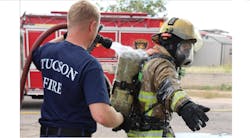Study: Cancer Signs Can Show Up Early in Firefighting Career
The chemicals that become airborne when a building burns are known to be dangerous to the health of firefighters working the blaze, but just how harmful and just how quickly?
The Tucson Fire Department and the University of Arizona's Mel and Enid Zuckerman College of Public Health have been working together on these questions, and recently released a report about how soon carcinogens and other exposures can make a new firefighter susceptible to diseases, including cancer.
The report shows biological changes can take place relatively early in a person's career, depending on the number of structural fires attended and the length of time spent fighting these fires. The increased risk is examined through an area of study called epigenetics, which looks at how exposures and behaviors change how a person's genes work.
The idea for this work started locally about eight years ago after a firefighter named Tom Quesnel became sick with leukemia. Quesnel, the department's longtime arson investigator, was having a hard time with his compensation claim. Quesnel died in March 2014 after he spent 20 years investigating nearly 3,000 fires throughout the Southwest.
"He's the one that was the why for us, because of the challenges he faced with his diagnosis," said Darin Wallentine, Tucson Fire's deputy chief for the safety and wellness division. "He's why we're doing what we're doing today."
Quesnel's colleagues reached out to the UA, and Dr. Jefferey L. Burgess, to better understand — and better quantify — firefighter cancer risks.
Burgess' research includes the evaluation and the prevention of carcinogenic exposures to not only firefighters but also miners, Native Americans and those exposed to arsenic in their water and food.
A three-year study, funded by the Federal Emergency Management Agency, started in 2015 and included following up to 600 of Tucson's firefighters. Researchers studied their exposure to carcinogens through the skin, and contamination via inhalation of smoke, diesel exhaust and other chemical gases, vapors and particulates.
The Tucson Fire Department and the UA researchers have since joined efforts with other departments, universities and government agencies to form the national Fire Fighter Cancer Cohort Study, which currently includes more than 30 other fire departments nationwide.
In the local study, Burgess and his research team obtained blood samples from 50 non-smoking new firefighter recruits prior to their first live fire and again 20 to 37 months later. In the latter samples, they found changes at 680 different sites on the firefighters' genomes — a set of genes or genetic material present in a cell — many of which were in genes related to cancers and immune and neurological function as well as other diseases, including cardiovascular disease.
One goal is to do enough research to have the International Agency for Research on Cancer, which is part of the World Health Organization, increase the risk level for firefighters from where they are now, with the profession classified as "possibly carcinogenic" to "probably carcinogenic" and then, in time, to "known carcinogenic."
These designations will help improve the safety and lives of firefighters everywhere, Wallentine said, by making it easier to have their claims supported if they get sick, and to research and fund prevention efforts better.
This research is also helping them make improvements to keep firefighters safe while they work, he said. The findings have already changed how they do their job in a few ways.
One of the changes is doing what they call a preliminary washdown, which includes firefighters using dish soap and a scrub brush on the outer shell of their gear at the fire scene and then storing that gear in a bag in the trucks so the air in the cab stays clear.
Firefighters here are now also using oxygen tanks longer, and those who drive the trucks and work the water pumps are now putting on air packs to protect them from smoke and carcinogens that go airborne outside the site of a building fire.
Tucson Fire also has installed industrial washing machines at stations so the gear can be more easily laundered, and firefighters have been given a second set of gear to use if the first is still in the washer when a new emergency arises.
The paper, "Repeat measures of DNA methylation in an inception cohort of firefighters," was published in the journal Occupational & Environmental Medicine.
Contact reporter Patty Machelor at 806-7754 or
___
(c)2022 The Arizona Daily Star (Tucson, Ariz.)
Visit The Arizona Daily Star (Tucson, Ariz.) at www.tucson.com
Distributed by Tribune Content Agency, LLC.
